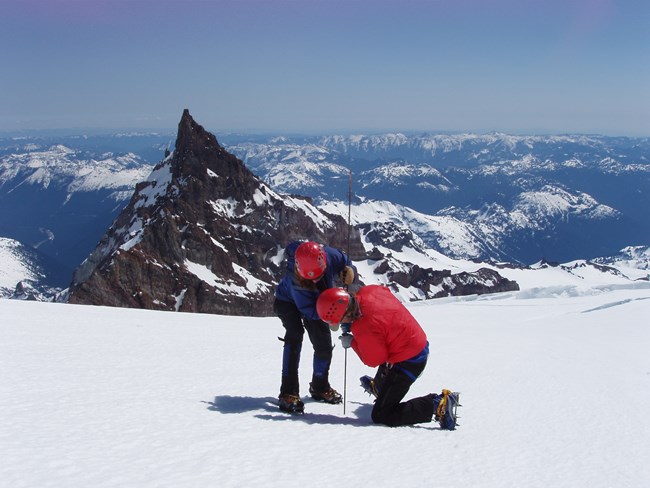
NPS Photo
Importance & Issues
Glaciers play a significant role in mountain ecosystems throughout the world, including the three large parks in the North Coast and Cascades Network (Mount Rainier, North Cascades, and Olympic National Parks) where there are 516 glaciers larger than 0.1 km2. Combined, the glaciers cover 211 km2 (52,140 acres) in these three parks.
Glaciers are integral components of the region's hydrologic, ecologic, and geologic systems. They deliver cold sediment and nutrient-rich water to the region's aquatic ecosystems. The melt water peaks during the hot dry summer season, buffering these ecosystems during droughts. On the Skagit River, glaciers contribute between 6-12% of summer streamflow.
Glaciers in the Pacific Northwest are retreating rapidly. Geologic mapping data, old maps and airphotos, and a recent inventory indicate that glacier area has declined about 53% at North Cascades National Park, 27% at Mount Rainier National Park, and 52% at Olympic National Park in the last century.
Monitoring Objectives
-
Monitor range of variation and trends in volume of North Cascades and Mount Rainier National Parks glaciers
-
Relate glacier changes to status of aquatic and terrestrial ecosystems and hazards
-
Link glacier observations to research on climate and ecosystem change
-
Share information on glaciers with the public and professionals
Basic Approach
For six index glaciers, we estimate winter accumulation, summer melt, annual glacial mass balance (net change), and equilibrium line altitude. We also determine glacier volume and surface elevation for index glaciers at 10-year intervals and glacier area for all glaciers at 20 year intervals; assess surface feature (lakes, crevasse patterns, debris cover) changes related to glacial hazards; assess snow surface cover at index glaciers in the late fall; and estimate the glacial contribution to summer streamflow in four watersheds at North Cascades National Park and two at Mount Rainier National Park. We also record glacier changes through repeat annual photography from established photopoints.
Management Applications
The sensitive and dynamic response of glaciers to variations in both temperature and precipitation makes them excellent indicators of regional and global climate change at multiple time scales. In tracking glacial extent and mass balance, management gains insights into the interconnected role glaciers play in terrestrial and hydrological ecosystems, including changes in the distribution of aquatic and terrestrial habitat from glacial advances and retreats and the amount of cold, turbid meltwater released into aquatic habitats. Endangered species such as salmon, bull trout, and western cutthroat trout depend on the persistence and stability glaciers provide to their environment. Hydroelectric and agricultural industries, among others, benefit from understanding glaciers contribution to the region's hydrologic systems.
Reports and Documents
Source: NPS DataStore Saved Search 559. To search for additional information, visit the NPS DataStore.
Source: NPS DataStore Saved Search 3698. To search for additional information, visit the NPS DataStore.
Last updated: May 25, 2023
